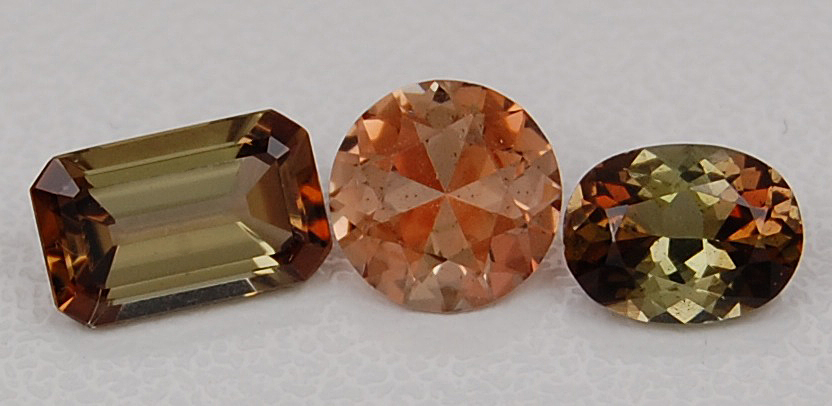
Introduction: Andalusite is a mineral species. Pictured above (from left to right) are 1.86 ct emerald cut, 1.74 ct round and 1.15 ct oval.
Colors: brownish or yellowish-green to brownish-orange. Often, both pleochroic colors of green and orange are visible in the face up position. It can also be pure green (viridine) as well as brownish-orange.
Clarity: Andalusite is of Type II clarity. Gems in this type typically grow with some minor inclusions in nature that may be eye visible but usually are well hidden or require magnification. Veils and needle shaped inclusions of rutile are commonly seen.
Stone Sizes: Usually gems are less than 5 carats with an occasional stone in the 10 carat range. Gems over 20 carats are exceptionally rare in fine quality.
Localities:
-Brazil and Sri Lanka are considered the main sources.
Treatments:
-None known
Gemology:
-Refractive Index: 1.634-1.643 (+/-0.005)
-Birefringence: 0.007 to 0.013
-Optic Character: Doubly refractive, biaxial negative
-Dispersion: 0.016
-Specific Gravity: 3.17 (+/-0.04)
-Hardness: 7 to 7.5
-Toughness: fair to good
-Chemical Composition: Al2SiO5
-Cause of Color: charge transfers involving titanium and iron oxygen ion pairs. In viridine, the cause of color is from manganese.
-Absorption Spectra: Not distinctive in orange/green variety but the pure green variety of viridine shows a rare earth spectrum with lines at 558, 551, 521, 511 and 497 nm.
-Fluorescence: inert (LW) and inert to moderate green to yellowish-green (SW)
-Cleavage: distinct, one direction
-Phenomena: None. An opaque variety, known as chiastolite, can show a dark cross like pattern on a white, gray, reddish or brown background.
Name: Andalusite is named after the first known locality in Andalusia, Spain.
Dates: None.
Care: The ultrasonic is usually safe but the steam cleaner can be risky if liquid inclusions are present. Warm, soapy water is safe.
To see available andalusites, click here.
